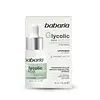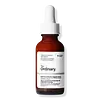What's inside
What's inside
 Key Ingredients
Key Ingredients

 Benefits
Benefits

 Concerns
Concerns

 Ingredients Side-by-side
Ingredients Side-by-side

Water
Skin ConditioningGlycolic Acid
BufferingTri (Polyglyceryl-3/Lauryl) Hydrogenated Trilinoleate
EmulsifyingPolyacrylate-13
Sodium Hydroxide
BufferingBrassica Campestris Sterols
EmollientZingiber Officinale Root Extract
MaskingHydroxyphenyl Propamidobenzoic Acid
Skin ConditioningBisabolol
MaskingMannitol
HumectantPhosphatidylcholine
EmulsifyingGlycerin
Humectant4-T-Butylcyclohexanol
MaskingCeramide NP
Skin ConditioningCetylhydroxyproline Palmitamide
Skin ConditioningPhenoxyethanol
PreservativePolyisobutene
Hexyldecanol
EmollientPentylene Glycol
Skin ConditioningAmmonium Acryloyldimethyltaurate/Vp Copolymer
Tocopheryl Acetate
AntioxidantAminomethyl Propanol
BufferingParfum
MaskingTetrasodium EDTA
Polysorbate 20
EmulsifyingSorbitan Isostearate
EmulsifyingEthylhexylglycerin
Skin ConditioningStearic Acid
CleansingDecyl Glucoside
CleansingCetyl Alcohol
EmollientPotassium Sorbate
PreservativeSodium Benzoate
MaskingXanthan Gum
EmulsifyingSodium Chloride
MaskingCitronellol
PerfumingGeraniol
PerfumingLinalool
PerfumingWater, Glycolic Acid, Tri (Polyglyceryl-3/Lauryl) Hydrogenated Trilinoleate, Polyacrylate-13, Sodium Hydroxide, Brassica Campestris Sterols, Zingiber Officinale Root Extract, Hydroxyphenyl Propamidobenzoic Acid, Bisabolol, Mannitol, Phosphatidylcholine, Glycerin, 4-T-Butylcyclohexanol, Ceramide NP, Cetylhydroxyproline Palmitamide, Phenoxyethanol, Polyisobutene, Hexyldecanol, Pentylene Glycol, Ammonium Acryloyldimethyltaurate/Vp Copolymer, Tocopheryl Acetate, Aminomethyl Propanol, Parfum, Tetrasodium EDTA, Polysorbate 20, Sorbitan Isostearate, Ethylhexylglycerin, Stearic Acid, Decyl Glucoside, Cetyl Alcohol, Potassium Sorbate, Sodium Benzoate, Xanthan Gum, Sodium Chloride, Citronellol, Geraniol, Linalool
Water
Skin ConditioningPropanediol
SolventIsodecyl Neopentanoate
EmollientPentylene Glycol
Skin ConditioningNiacinamide
SmoothingHexyldecanol
EmollientCetearyl Alcohol
EmollientXylitylglucoside
HumectantCeteth-20 Phosphate
CleansingAnhydroxylitol
HumectantEthyl Linoleate
EmollientAsiaticoside
AntioxidantAsiatic Acid
Skin ConditioningMadecassic Acid
Skin ConditioningNaringenin
Skin ConditioningCyanocobalamin
Skin ConditioningPanthenyl Triacetate
4-T-Butylcyclohexanol
MaskingHydroxyphenyl Propamidobenzoic Acid
Skin ConditioningCetylhydroxyproline Palmitamide
Skin ConditioningBisabolol
MaskingBrassica Campestris Sterols
EmollientSphingolipids
EmollientPhospholipids
Skin ConditioningEpigallocatechin Gallatyl Glucoside
AntioxidantGallyl Glucoside
AntioxidantPropyl Gallate
AntioxidantXylitol
HumectantZingiber Officinale Root Extract
MaskingStearic Acid
CleansingDicetyl Phosphate
EmulsifyingIsoceteth-20
EmulsifyingXanthan Gum
EmulsifyingTrisodium Ethylenediamine Disuccinate
Tocopherol
AntioxidantDehydroacetic Acid
PreservativeP-Anisic Acid
MaskingPhytic Acid
Sodium Phytate
Sodium Citrate
BufferingSodium Hydroxide
BufferingBenzyl Alcohol
PerfumingEthylhexylglycerin
Skin ConditioningPhenoxyethanol
PreservativeChlorphenesin
AntimicrobialWater, Propanediol, Isodecyl Neopentanoate, Pentylene Glycol, Niacinamide, Hexyldecanol, Cetearyl Alcohol, Xylitylglucoside, Ceteth-20 Phosphate, Anhydroxylitol, Ethyl Linoleate, Asiaticoside, Asiatic Acid, Madecassic Acid, Naringenin, Cyanocobalamin, Panthenyl Triacetate, 4-T-Butylcyclohexanol, Hydroxyphenyl Propamidobenzoic Acid, Cetylhydroxyproline Palmitamide, Bisabolol, Brassica Campestris Sterols, Sphingolipids, Phospholipids, Epigallocatechin Gallatyl Glucoside, Gallyl Glucoside, Propyl Gallate, Xylitol, Zingiber Officinale Root Extract, Stearic Acid, Dicetyl Phosphate, Isoceteth-20, Xanthan Gum, Trisodium Ethylenediamine Disuccinate, Tocopherol, Dehydroacetic Acid, P-Anisic Acid, Phytic Acid, Sodium Phytate, Sodium Citrate, Sodium Hydroxide, Benzyl Alcohol, Ethylhexylglycerin, Phenoxyethanol, Chlorphenesin
 Reviews
Reviews

Ingredients Explained
These ingredients are found in both products.
Ingredients higher up in an ingredient list are typically present in a larger amount.
4-T-Butylcyclohexanol has skin soothing and perfuming/masking properties.
A study from 2016 found it to have skin-soothing properties both in-vivo and in-vitro. It works by intercepting the signals of irritation and can soothe the skin in a few minutes.
According to a manufacturer, this ingredient has a scent similar to musk or patchouli. Besides having a skin soothing effect, it can also help cover other unpleasant scents as a masking ingredient.
Learn more about 4-T-ButylcyclohexanolBisabolol is famous for its skin soothing properties. It does this by blocking inflammatory signals, helping to reduce your body's reaction to irritation.
This ingredient also interferes with the process of hyperpigmentation. This can help with reducing dark spots and uneven tone.
Bisabolol is an antioxidant. Antioxidants help fight free-radicals. Free-radicals are molecules that may damage your skin cells. By fighting these free-radicals, Bisabolol may slow down signs of aging.
Studies have shown Bisabolol to have antimicrobial properties and may be a fungicide. These properties help preserve a product's shelf life.
All these properties makes bisabolol a great skin barrier helper ingredient.
Bisabolol also helps the absorption of other ingredients.
Note: Synthetic Bisabolol has been shown to be less effective.
Learn more about BisabololBrassica Campestris Sterols isn't fungal acne safe.
We don't have a description for Cetylhydroxyproline Palmitamide yet.
Ethylhexylglycerin (we can't pronounce this either) is commonly used as a preservative and skin softener. It is derived from glyceryl.
You might see Ethylhexylglycerin often paired with other preservatives such as phenoxyethanol. Ethylhexylglycerin has been found to increase the effectiveness of these other preservatives.
Hexyldecanol is a fatty alcohol with emollient and skin conditioning properties. Fatty alcohols are non-drying.
According to a manufacturer, this ingredient is suitable for a wide range of pH.
We don't have a description for Hydroxyphenyl Propamidobenzoic Acid yet.
Pentylene glycol is typically used within a product to thicken it. It also adds a smooth, soft, and moisturizing feel to the product. It is naturally found in plants such as sugar beets.
The hydrophilic trait of Pentylene Glycol makes it a humectant. As a humectant, Pentylene Glycol helps draw moisture from the air to your skin. This can help keep your skin hydrated.
This property also makes Pentylene Glycol a great texture enhancer. It can also help thicken or stabilize a product.
Pentylene Glycol also acts as a mild preservative and helps to keep a product microbe-free.
Some people may experience mild eye and skin irritation from Pentylene Glycol. We always recommend speaking with a professional about using this ingredient in your routine.
Pentylene Glycol has a low molecular weight and is part of the 1,2-glycol family.
Learn more about Pentylene GlycolPhenoxyethanol is a preservative that has germicide, antimicrobial, and aromatic properties. Studies show that phenoxyethanol can prevent microbial growth. By itself, it has a scent that is similar to that of a rose.
It's often used in formulations along with Caprylyl Glycol to preserve the shelf life of products.
Sodium Hydroxide is also known as lye or caustic soda. It is used to adjust the pH of products; many ingredients require a specific pH to be effective.
In small amounts, sodium hydroxide is considered safe to use. However, large amounts may cause chemical burns due to its high alkaline.
Your skin has a natural pH and acid mantle. This acid mantle helps prevent harmful bacteria from breaking through. The acid mantle also helps keep your skin hydrated.
"Alkaline" refers to a high pH level. A low pH level would be considered acidic.
Learn more about Sodium HydroxideStearic Acid is a fatty acid. It is an emollient, emulsifier, and texture enhancer.
As an emollient, stearic acid helps soften skin. It aids the skin's protective barrier by preventing water loss. It also provides a gentle cleansing effect without stripping away natural oils.
Stearic acid may also be used to enhance the texture of products. It can add volume and stabilize ingredients such as water and oil. This can help water and oil ingredients from separating.
Sources of stearic acid include animal or vegetable fats/oils such as coconut or shea. It can be naturally found in butter, cocoa butter, shea butter, vegetable fats, and animal tallow.
This ingredient may not be Malassezia folliculitis, or fungal-acne safe.
Learn more about Stearic AcidWater. It's the most common cosmetic ingredient of all. You'll usually see it at the top of ingredient lists, meaning that it makes up the largest part of the product.
So why is it so popular? Water most often acts as a solvent - this means that it helps dissolve other ingredients into the formulation.
You'll also recognize water as that liquid we all need to stay alive. If you see this, drink a glass of water. Stay hydrated!
Learn more about WaterXanthan gum is used as a stabilizer and thickener within cosmetic products. It helps give products a sticky, thick feeling - preventing them from being too runny.
On the technical side of things, xanthan gum is a polysaccharide - a combination consisting of multiple sugar molecules bonded together.
Xanthan gum is a pretty common and great ingredient. It is a natural, non-toxic, non-irritating ingredient that is also commonly used in food products.
Learn more about Xanthan GumZingiber Officinale is more commonly known as ginger.
Ginger root has antioxidant, anti-inflammation, and antimicrobial properties.
The antioxidant properties help protect your body from free-radicals. Free-radicals are molecules that may damage your skin cells. As a result, ginger may help slow down signs of aging such as hyperpigmentation and wrinkles.
Studies show ginger inhibits the enzyme that breaks down collagen. It also helps with:
This ingredient has no negative side-effects and is safe to use unless one has a specific allergy to it.
Ginger originates from Southeast Asia but has spread throughout the world. It is now a common spice used in many cultures.
Learn more about Zingiber Officinale Root Extract